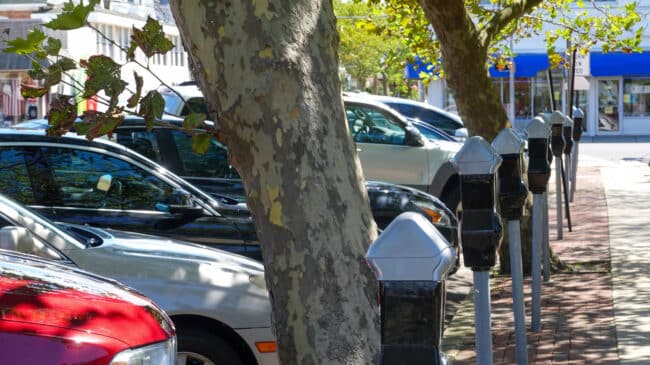Since the middle of the 20th century, the majority of Americans have owned cars. The automobile has helped individuals travel long distances in short amounts of time, enhancing their freedom by providing more choice for residency, work, and leisure. However, owning a car is not free; automobiles need fuel, maintenance, registration, and insurance. And one of the most important needs, parking, is often unpriced or underpriced.
Free parking is not a problem in most suburban areas. Most residential areas have homes with driveways and garages. Shopping centers and supercenters typically provide lots of parking spaces for their customers on low-priced land. According to a study conducted by the University of California at Berkeley’s Civil and Environmental Engineering Department, for every registered car in the U.S., there are 3.4 parking spaces. Other well-informed estimates put that number as high as eight parking spaces. Many of these lots are built to handle the busiest shopping day of the year, which means there are many empty spaces nearly all the time
Each standard parking spot in the U.S. is about 180 square feet. The average amount of driveway needed for each parking space increases the area needed to park a single car to 288 square feet. To put this amount of space into some perspective, the amount of paved parking areas in the four states of Michigan, Indiana, Illinois, and Wisconsin is enough to cover half the state of Rhode Island.
The answer to why we have so many parking spaces in the U.S. lies in part within city codes. Parking minimums are often mandated by cities for new construction and require new developments to provide a certain number of off-street parking spaces. The use of the building (e.g., a restaurant, bar, store, apartment building) imposes minimum off-street parking requirements based on area. For example, many suburban communities require one parking space per 250 square feet of retail space. Since the average parking space requires 288 square feet, most parking lots are 15 percent larger than the actual stores that they serve.
Parking minimums impose additional costs that new business developments must incur in order to operate. While a surface parking lot costs $1,500-$2,000 per space depending on zoning requirements, in more-dense areas the cost is $21,500 per space. For smaller businesses and developers, these additional costs can be a major obstacle to opening successfully. Developers can request variances, but cities normally charge a large fee, which still creates a hefty cost for a business to shoulder. Some cities, in order to offset this burden on developers and businesses, create public parking in their business districts. These parking structures can cost millions of taxpayer dollars and often times the benefits don’t come close to outweighing the cost.
When it comes to fixing our parking problems, there are three tangible actions that cities can take. First, cities should consider removing or significantly reducing their parking minimums. Cities with limited transit services are less equipped to deal with limited parking. Parking minimums should be reduced to prevent a surplus of parking and the total number of spaces should be determined by the market. According to Strong Towns, an organization that pushes for the removal of parking requirements, 121 cities in the U.S. have removed parking minimums in at least one of their neighborhoods. An additional 62 cities are in the process of removing or considering removing parking minimums. In the cities that have removed parking minimums, rent has decreased (a 2016 study estimated that parking minimums added an average of $621 per year in rent per household, equating to a 13% rent increase. This figure is as high as $1,700 annually in rental costs for garaged parking), the density of city blocks has increased, and historic neighborhoods and communities have been protected and revitalized.
Cities should also incentivize developers to build on lots that they own. Hartford, Connecticut is doing this by creating a new parking tax. Many cities whose downtowns are covered in parking lots charge a much lower tax rate for land that is dedicated to parking lots than on land that has improvements and developments. Developers are not incentivized to develop the parking lots they don’t own because of the tax increase they would incur.
Finally, cities should dynamically meter curbside parking. According to Donald Shoup, an urban planning professor at UCLA and author of multiple books on parking theory, the ideal metered parking should be the lowest amount that can be charged while maintaining at least one or two open spots on every block. This model would avoid claims of parking shortages as well as prioritize market principles. Depending on demand, the cost of parking may need to increase in order to maintain an open spot, meaning it would be more expensive to park during peak times.
In Seattle, the city extended the parking meter hours from 6 pm to 8 pm, and, despite fears from restaurant owners that the fee would cut into their business, restaurant profits actually increased 9% that year. While it is unclear if the time extension cut into the potential profits of these businesses compared to if their patrons were not charged for parking during that time, it is clear that the parking charges did not create revenue losses for these downtown businesses compared to years prior.
For too long, cities have prioritized subsidizing free parking in order to allow ease of mobility by automobiles, but economically this does not make sense. Ultimately, taxpayers (even the ones that don’t own cars) and customers at businesses are paying the costs of free parking. We need to change our approach towards parking.

